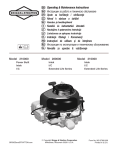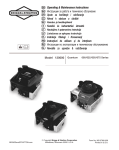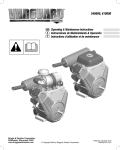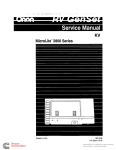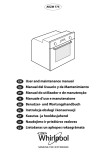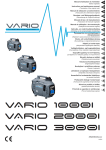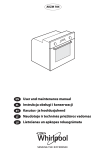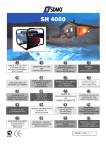Download Briggs & Stratton 610000 Technical information
Transcript
CZ Operating & Maintenance Instructions Èíñòðóêöèè çà ðàáîòà è òåõíè÷åñêî îáñëóæâàíå Upute za koričtenje i odrďavanje Návod k obsluze a údrďbì EE Kasutus− ja hooldusjuhend H Kezelési és karbantartási útmutató LT Naudojimo ir aptarnavimo instrukcija LietoĠanas un apkopes instrukcija GB BG CR LV PL RO RU SL Instrukcja Obs³ugi i Konserwacji Instrucþiuni de utilizare ºi de întreþinere Èíñòðóêöèè ïî ýêñïëóàòàöèè è òåõíè÷åñêîìó îáñëóæèâàíèþ Navodila za uporabo & vzdrďevanje Model 540000 BRIGGSandSTRATTON.com Vanguard Model 610000 Vanguard E Copyright Briggs & Stratton Corporation Milwaukee, Wisconsin 53201 U.S.A. Form No. MS-3882-12/06 Printed in U.S.A. Fig. 1 12 12 12 19 1 11 10 13 2 14 3 3 4 18 5 15 9 6 16 8 17 7 7 20 19 Fig. 3 1 Ê Fig. 2 ** * Í Ì Ë GB Note: (This note applies only to engines used in the U.S.A.) Maintenance, replacement or repair of the emission control devices and systems may be performed by any nonroad engine repair establishment or individual. However, to obtain no charge repairs under the terms and provisions of the Briggs & Stratton warranty statement, any service or emission control part repair or replacement must be performed by a factory authorized dealer. ENGINE COMPONENTS Fig. 1 1 2 3 4 5 6 7 8 9 10 11 12 13 14 15 16 17 18 19 Choke Control (if equipped) Breather/Breather tube Spark Plug (2 locations) Engine Model Label Model xxxxxx Type xxxxxx Code xxxxxxxx Oil Pressure Sensor Oil Filter Oil Drain Plug (2 locations) Rotating Screen Cover − Carburetor Carburetor or LPG/NG Mixer Mechanical Fuel Pump Air Cleaner Oil Fill Dipstick Regulator/Rectifier Starter Solenoid Starter Exhaust System/Muffler Throttle control (2 locations) Record your engine Model, Type and Code numbers here for future use. Record your date of purchase here for future use. TECHNICAL INFORMATION GENERAL INFORMATION This is a twin cylinder, overhead valve (OHV), air-cooled engine. It is a low emissions engine. In the state of California, Model 540000 and 610000 engines are certified by the California Air Resources Board to meet emissions standards for 1000 hours. Such certification does not grant the purchaser, owner or operator of this engine any additional warranties with respect to the performance or operational life of this engine. This engine is warranted solely according to the product and emissions warranties stated elsewhere in this manual. DANGER indicates a hazard which, if not avoided, will result in death or serious injury. WARNING indicates a hazard which, if not avoided, could result in death or serious injury. Bore . . . . . . . . . . . . . . . . . . . . . . . 85.5 mm (3.36 in.) Stroke . . . . . . . . . . . . . . . . . . . . . . . 78 mm (3.07 in.) Displacement . . . . . . . . . . . . . . . 895 cc (54.6 cu. in.) CAUTION indicates a hazard which, if not avoided, might result in minor or moderate injury. CAUTION, when used without the alert symbol, indicates a situation that could result in damage to the engine. Model 610000 Bore . . . . . . . . . . . . . . . . . . . . . . . 85.5 mm (3.36 in.) Stroke . . . . . . . . . . . . . . . . . . . . . 86.5 mm (3.04 in.) Displacement . . . . . . . . . . . . . . . 993 cc (60.6 cu. in.) Note: For practical operation, the horsepower loading should not exceed 85% of rated horsepower. Engine power will decrease 3-1/2% for each 1,000 feet (300 meters) above sea level and 1% for each 10° F (5.6° C) above 77° F (25° C). Engine will operate satisfactorily at an angle up to 25°. ) The safety alert symbol is used to identify safety information about hazards that can result in personal injury. A signal word (DANGER, WARNING, or CAUTION) is used with the alert symbol to indicate the likelihood and the potential severity of injury. In addition, a hazard symbol may be used to represent the type of hazard. Model 540000 WARNING The engine exhaust from this product contains chemicals known to the State of California to cause cancer, birth defects, or other reproductive harm. Hazard Symbols and Meanings TUNE-UP SPECIFICATIONS Armature air gap . . . 0.13 − 0.20 mm (0.005 − 0.008 in.) Spark plug gap . . . . . . . . . . . . . . . 0.76 mm (0.030 in.) Valve clearance with valve springs installed and piston 6 mm (1/4 in.) past top dead center (check when engine is cold). Intake . . . . . . . . . . . 0.10 − 0.15 mm (0.004 − 0.006 in.) Exhaust . . . . . . . . . 0.10 − 0.15 mm (0.004 − 0.006 in.) Explosion Fire Toxic Fumes Moving Parts Hot Surface Kickback Shock Frostbite SAFETY SPECIFICATIONS Engine Power Rating Information The gross power rating for individual gas engine models is labeled in accordance with SAE (Society of Automotive Engineers) code J1940 (Small Engine Power & Torque Rating Procedure), and rating performance has been obtained and corrected in accordance with SAE J1995 (Revision 2002-05). Actual gross engine power will be lower and is affected by, among other things, ambient operating conditions and engine-to-engine variability. Given both the wide array of products on which engines are placed and the variety of environmental issues applicable to operating the equipment, the gas engine will not develop the rated gross power when used in a given piece of power equipment (actual on-site" or net horsepower). This difference is due to a variety of factors including, but not limited to, accessories (air cleaner, exhaust, charging, cooling, carburetor, fuel pump, etc.), application limitations, ambient operating conditions (temperature, humidity, altitude), and engine-toengine variability. Due to manufacturing and capacity limitations, Briggs & Stratton may substitute an engine of higher rated power for this Series engine. ( GB Wear Eye Protection BEFORE OPERATING ENGINE • Read entire Operating & Maintenance Instructions AND the instructions for the equipment this engine powers.* • Failure to follow instructions could result in serious injury or death. * Briggs & Stratton does not necessarily know what equipment this engine will power. For that reason, you should carefully read and understand the operating instructions for the equipment on which your engine is placed. THE OPERATING & MAINTENANCE INSTRUCTIONS CONTAIN SAFETY INFORMATION TO: • Make you aware of hazards associated with engines • Inform you of the risk of injury associated with those hazards, and • Tell you how to avoid or reduce the risk of injury. International Hazard Symbols and Meanings Safety Alert Oil Read Operator’s Manual Choke Stop Fuel On Off Fuel Shutoff WARNING Starting engine creates sparking. Sparking can ignite nearby flammable gases. Explosion and fire could result. • If there is natural or LP gas leakage in area, do not start engine. • Do not use pressurized starting fluids because vapors are flammable. 1 GB WARNING WARNING WARNING Running engines produce heat. Engine parts, especially muffler, become extremely hot. Severe thermal burns can occur on contact. Combustible debris, such as leaves, grass, brush, etc. can catch fire. Gaseous fuels are extremely flammable and readily form explosive air-vapor mixtures at ambient temperatures. Gasoline and its vapors are extremely flammable and explosive. Fire or explosion can cause severe burns or death. IF YOU SMELL GAS: WHEN ADDING FUEL • Turn engine OFF and let engine cool at least 2 minutes before removing gas cap. • Fill fuel tank outdoors or in well-ventilated area. • Do not overfill fuel tank. Fill tank to approximately 1-1/2 inches below top of neck to allow for fuel expansion. • Keep gasoline away from sparks, open flames, pilot lights, heat, and other ignition sources. • Check fuel lines, tank, cap, and fittings frequently for cracks or leaks. Replace if necessary. WHEN STARTING ENGINE • Make sure spark plug, muffler, fuel cap and air cleaner are in place. • Do not crank engine with spark plug removed. • If fuel spills, wait until it evaporates before starting engine. • If engine floods, set choke to OPEN/RUN position, place throttle in FAST and crank until engine starts. WHEN OPERATING EQUIPMENT • Do not tip engine or equipment at angle which causes gasoline to spill. • Do not choke carburetor to stop engine. WHEN TRANSPORTING EQUIPMENT • Transport with fuel tank EMPTY or with fuel shut-off valve OFF. • On NATURAL / LIQUID PETROLEUM (LP) GAS engines transport with fuel cylinder empty or valve closed, or tank disconnected. • • • • • DO NOT start the engine. DO NOT actuate any electrical switches. DO NOT use the phone in the vicinity. Evacuate the area. Contact the gas supplier or fire department. REMEMBER: • LPG vapor is heavier than air and trends to collect in low areas. NG vapor is lighter than air and tends to collect in high areas. Both may travel to remote locations. • Keep all flames, sparks, pilot lights, and other ignition sources away from the area where the engine is operated or repaired. • DO NOT smoke when operating or repairing the engine. • DO NOT store gasoline or other flammable vapors or liquids in the vicinity of the engine. • BEFORE doing any service work to the engine, shut off the gas supply. • After initial installation or servicing, check for gas leaks. DO NOT use an open flame. Apply very soapy water or leak test solution with a brush and look for bubbles. • Keep the equipment and the area surrounding the engine free of debris. • Install the fuel system according to applicable fuel/gas codes. Unintentional sparking can result in fire or electric shock. Unintentional start-up can result in entanglement, traumatic amputation, or laceration. BEFORE PERFORMING ADJUSTMENTS OR REPAIRS • Disconnect spark plug wire and keep it away from spark plug. • Disconnect battery at negative terminal (only engines with electric start). • Use approved spark plug tester. • Do not check for spark with spark plug removed. • Store away from furnaces, stoves, water heaters or other appliances that have pilot light or other ignition source because they can ignite gasoline vapors. WARNING Rotating parts can contact or entangle hands, feet, hair, clothing, or accessories. Traumatic amputation or severe laceration can result. • • • • Operate equipment with guards in place. Keep hands and feet away from rotating parts. Tie up long hair and remove jewelry. Do not wear loose-fitting clothing, dangling drawstrings or items that could become caught. WARNING • Installation, adjustment and repair work should be done by a qualified technician. • Flexible supply lines should be checked regularly to make sure they are in good condition. Replace damaged or leaking components. WARNING WHEN TESTING FOR SPARK WHEN STORING FUEL OR EQUIPMENT WITH FUEL IN TANK Wear eye protection when doing repair work. Frostbite can result from skin/eye contact with leaking LP liquid. • Allow muffler, engine cylinder and fins to cool before touching. • Remove accumulated combustibles from muffler area and cylinder area. • Install and maintain in working order a spark arrester before using equipment on forest-covered, grass-covered, brush-covered unimproved land. The state of California requires this (Section 4442 of the California Public Resources Code). Other states may have similar laws. Federal laws apply on federal land. WARNING Engines give off carbon monoxide, an odorless, colorless, poison gas. Breathing carbon monoxide can cause nausea, fainting or death. • Start and run engine outdoors. • Do not start or run engine in enclosed area, even if doors or windows are open. 2 OIL RECOMMENDATIONS CAUTION: This engine is shipped from Briggs & Stratton without oil. Check oil level before starting engine. If you start the engine without oil, the engine will be damaged beyond repair and will not be covered under warranty. Oil capacity is about 2.3 liter (80 ounces)* *Approximate amount when changing oil and filter. Type of Oil to use • Use a high quality detergent oil classified For Service SF, SG, SH, SJ" or higher such as Briggs & Stratton 30, Part Number 100005 (20 oz) or 100028 (48 oz). • Use no special additives with recommended oils. • Do not mix oil with gasoline. • Choose the SAE viscosity grade of oil from this chart that matches the starting temperature anticipated before the next oil change. Fig. 2 * ** CAUTION: The use of non-synthetic multi-viscosity oils (5W-30, 10W-30, etc.) in temperatures above 40° F (4°C) will result in higher than normal oil consumption. When using a multi-viscosity oil, check oil level more frequently. CAUTION: Use of SAE 30 oil below 40° F (4° C) will result in hard starting and possible engine damage due to inadequate lubrication. GB Note: Synthetic oil meeting ILSAC GF-2, API certification mark and API service symbol (shown at left) with SJ/CF ENERGY CONSERVING" or higher, is an acceptable oil at all temperatures. Use of synthetic oil does not alter required oil change intervals. supplied by the equipment manufacturer to determine which way your engine is equipped.) See OIL PRESSURE in the MAINTENANCE SECTION for oil filling instructions. STARTING IN COLD WEATHER: ♦ Use correct type of oil for expected starting temperature. See Oil. ♦ Use fresh gasoline, which has higher volatility to improve starting. ♦ Remove external equipment/engine loads. (See equipment operating instructions.) ♦ Open fuel shut-off valve, if equipped, before starting engine. ♦ Allow engine to warm up several seconds to several minutes, depending on outside temperature. ♦ Gradually open choke. ♦ For maximum performance and life, operate engine with choke in OPEN and throttle in FAST. CHECKING AND ADDING OIL Fig. 3 • • • • Check oil level before starting the engine. Check level daily, or after every eight (8) hours . Keep oil level at FULL . Do not overfill. Oil filling procedure: 1. First add 2 liters (67 ounces). 2. Start and run engine at idle for 30 seconds. See Starting Instructions. 3. Shut engine off and wait 30 seconds. 4. Then add more oil slowly to bring level to Full mark on TO START ENGINE Fig. 4 dipstick. 1. 2. 1. Place engine level. Clean around oil fill and dipstick . 3. 2. Remove dipstick and wipe clean with cloth. 4. 3. Then push dipstick back in and remove to check oil level. 5. Oil checking procedure: Oil should be at FULL line on dipstick . 4. If oil is needed, add slowly. 5. Fill to FULL line on dipstick − recheck. 6. Replace dipstick firmly. FUEL RECOMMENDATIONS Use clean, fresh, regular unleaded gasoline with a minimum of 85 octane. Fresh fuel prevents gum from forming in the fuel system or on essential carburetor parts. Purchase fuel in quantity that can be used within 30 days. • Do not use gasoline which contains Methanol. • Do not mix oil with gasoline. • For engine protection use Briggs & Stratton Gasoline Additive available from your Authorized Briggs & Stratton Dealer (P/N 5041 or single use pouch). This engine is certified to operate on gasoline. Exhaust Emission Control System: EM (Engine Modifications). CAUTION: Some fuels, called oxygenated or reformulated gasoline, are gasoline blended with alcohols or ethers. Excessive amounts of these blendscan damage the fuel system or cause performanceproblems. If any undesirable operating symptoms occur,use gasoline with a lower percentage of alcohol or ether. CAUTION: To prolong starter life, use short starting cycles (5 seconds maximum, then wait one minute). Follow equipment manufacturer’s recommendations for charging. 6. Allow engine to warm up. If choke equipped: Slowly adjust toward RUN position. Wait until engine runs smoothly before each choke adjustment. WARNING The manufacturer of the equipment on which this engine is installed specifies top speed at which the engine will be operated. DO NOT EXCEED this speed. 1. Remove cap. Fill tank to approximately 1-1/2 inches below top of neck to allow for fuel expansion. Be careful not to overfill. 2. Replace cap before starting. STARTING/STOPPING WARNING Fig. 4 If engine is equipped with an oil pressure switch, the switch will either activate a warning light or stop the engine when the engine runs low on oil. (Read the operating instructions TO START ENGINE Insert key and turn to START. CAUTION: To prolong starter life, use short starting cycles (5 seconds maximum, then wait one minute). Follow equipment manufacturer’s recommendations for charging. TO STOP ENGINE Turn key OFF. Remove key and store out of reach of children. MAINTENANCE Regular maintenance will improve the performance and extend the life of the engine. See any Authorized Briggs & Stratton Dealer for service. Use only genuine Briggs & Stratton parts. Other parts may not perform as well, may damage the engine, and may result in injury. In addition, use of other parts may void your warranty. ENGINE AND ENGINE PARTS We recommend that you see an authorized Briggs & Stratton Service Dealer for all maintenance and service of the engine and engine parts. Use only genuine Briggs & Stratton parts. Perform the following at recommended intervals: Every 8 hours or daily Check oil level Check for oil leaks Every 50 hours Check valve clearance * Clean spark arrester (if equipped) Every 100 hours or every season Change oil * Change oil filter * Clean air cleaner ** Check valve clearance on NG / LPG Engines. Every 250 hours 1. Move throttle to SLOW (if equipped) 2. Turn key OFF . Remove key and store out of reach of Replace air cleaner cartridge ** Change fuel filter Every 600 hours 3. Push rocker switch (if equipped) to OFF or STOP. 4. Close fuel shut-off valve (if equipped). Replace safety filter cartridge Yearly children. FUEL RECOMMENDATIONS • Use clean, dry fuel, free of moisture or any particulate material. Using fuels outside the following recommended values may cause performance problems. • In engines set up to run on LPG, commercial grade HD5 LPG is recommended. Recommended fuel composition is fuel with a minimum fuel energy of 2500 BTU’s/ft3 with maximum propylene content of 5% and butane and heavier gas content of 2.5% and minimum propane content of 90%. • NG or LPG engines are certified to operate on natural or liquid propane gas. WARNING OIL PRESSURE SWITCH Read the operating instructions supplied by the equipment manufacturer for information on refueling natural or LP gas engine. Check valve clearance Check battery electrolyte Every 400 hours TO STOP ENGINE NATURAL / LIQUID PROPANE GAS POWERED ENGINES ADDING FUEL WARNING Open fuel shut-off valve (if equipped). Move choke control to CHOKE or START . Move throttle (if equipped ) to FAST . Push rocker switch (if equipped ) to ON or RUN . Insert key and turn to START . ADDING FUEL The equipment on which this engine is mounted is equipped with an automatic safety gas fuel lock-off" valve. DO NOT operate the equipment if the fuel lock-off" valve is missing or inoperative. 3 Change spark plugs Change oil and filter after first 5 to 8 hours of use, then every 100 hours or every season. Change oil every 50 hours when operating the engine under heavy load or in high temperatures. Check valve clearance after first 50 hours of use, then every 250 hours. ** Clean more often under dusty conditions or when airborne debris is present. Replace air cleaner parts, if very dirty. * CHANGING OIL AND OIL FILTER Fig. 5 Change oil and filter after first 5 to 8 hours and every 100 hours thereafter. 1. With engine OFF but still warm, remove oil drain plug and drain oil into appropriate receptacle. Reinstall drain plug. 2. Remove oil filter . Before installing new filter, lightly oil filter gasket with fresh, clean oil. GB 3. Screw filter on by hand until gasket contacts oil filter adapter. Tighten 1/2 to 3/4 turn more. AIR CLEANER Fig. 7 Fig. 3 4. Place engine level. Remove oil fill cap and add fresh oil. Oil filling procedure: First, add 67 ounces (2 liters). Start and run engine at idle for 30 seconds. Shut engine off and wait 30 seconds. Then, add more oil slowly to bring level to Full mark on dipstick . Do not overfill. 5. Replace oil fill cap and dipstick. CAUTION: Used oil is a hazardous waste product. Dispose of used oil properly. Do not discard with household waste. Check with your local authorities, service center, or dealer for safe disposal/recycling facilities. OIL PRESSURE If oil pressure drops below 1-4 psi (.1-.2 kg/cm2), an oil pressure switch (if engine is equipped) will either activate a warning device or stop the engine. Check oil level with dipstick. If oil level is between ADD and FULL mark on dipstick, Do not try to restart engine. Contact an Authorized Briggs & Stratton Service Dealer. Do not operate engine until oil pressure is corrected. If oil level is below ADD mark on dipstick, add oil to bring level to FULL mark. Restart engine and check oil pressure. If pressure is normal, continue to operate engine. Note: Oil pressure gauge, if engine is equipped, is supplied by manufacturer of equipment. EMISSION CONTROL Maintenance, replacement or repair of the emission control devices and systems may be performed by any nonroad engine repair establishment or individual. However, to obtain no charge repairs under the terms and provisions of the Briggs & Stratton warranty statement, any service or emission control part repair or replacement must be performed by a factory authorized dealer. WARNING If you perform any maintenance on the engine, first disconnect the spark plug wires from the spark plugs, and disconnect the battery at the negative terminal (electric starter engines only) to prevent unintentional sparking. Unintentional sparking can result in fire or electric shock. Unintentional startup can result in entanglement, traumatic amputation or laceration. Use only correct tools. CAUTION: Do not use pressurized air or solvents to clean cartridge. Pressurized air can damage cartridge; solvents will dissolve cartridge. Clean Air Filter Cartridge every 100 hours. To clean cartridge, gently tap on end with handle of screwdriver. Replace cartridge every 400 hours. Clean and replace more often under dusty conditions. 1. Remove cover . 2. Remove cartridge , and inspect. Replace if very dirty or any damage occurs to cartridge. 3. Carefully clean out air cleaner cover. 4. Install cartridge in. 5. Install cover On Gasoline Engine: Install cover and lock clamps with rubber valve down. Gasoline Engine: Replace Safety Filter Cartridge every 600 hours, or with every other air filter cartridge replacement. To replace cartridge, pull carefully to remove from air cleaner body, ensure no debris enters engine. Install new safety cartridge first, then install air filter cartridge over safety filter. CLEANING DEBRIS Fig. 8 Daily or before every use, clean accumulated debris from engine. Keep linkage, springs and controls clean. Keep area around and behind muffler free of any combustible debris. Remove front carburetor cover , and clean around intake manifold and carburetor. CAUTION: Do not use water to clean engine parts. Water could contaminate fuel system. Low pressure compressed air may be used, be careful not to damage radiator fins. WARNING Engine parts should be kept clean to reduce the risk of overheating and ignition of accumulated debris. ÌÌ ÌÌ FUEL FILTER WARNING WARNING • Do not strike the flywheel with hammer or hard object. If done, the flywheel may shatter during operation. • Do not tamper with governor spring, links or other parts to increase engine speed. Drain fuel tank or close fuel shut-off valve before replacing fuel filter. Otherwise, fuel can leak out, creating a fire/explosion hazard.When replacing fuel filter, ensure clamps are tight and fuel flows into the same direction as the arrow marked FLOW. MUFFLER/FUEL SYSTEM SPARK PLUGS Fig. 6 Change spark plugs yearly. Use only Briggs & Stratton Spark Tester (part number 19368) to check for spark. Gap spark plug to 0.76 mm (.030 in.) gap . Note: In some areas, local law requires using resistor spark plug to suppress ignition signals. If this engine was originally equipped with resistor spark plugs, use same type for replacement. VALVE CLEARANCE Check valve clearance every 250 hours. (See Tune-up Specifications on page 1). parts for the mufWARNING Replacement fler must be the same and installed in the same position as the original parts, otherwise fire can occur. Replacement parts for fuel system (cap, hoses, tanks, filters, etc.) must be the same as original parts, otherwise fire can occur. STORAGE Engines stored over 30 days need special attention. 1. To prevent gum from forming in fuel system or on essential carburetor parts: a) if fuel tank contains oxygenated or reformulated gasoline (gasoline blended with an alcohol or an ether), 4 run engine until it stops from lack of fuel, or b) if fuel tank contains gasoline, either run engine until it stops from lack of fuel, or add a gasoline additive to the gas in the tank. (See parts list. Single-use pouches of gas additive are available from your service dealer.) If you use a gas additive, run the engine for several minutes to circulate the additive through the carburetor. Then, engine and fuel can be stored up to 24 months. 2. While engine is still warm, change oil. 3. Remove spark plugs and pour about 1 oz. (30 ml) of engine oil into each cylinder. Replace spark plugs and crank slowly to distribute oil. 4. Clean engine of surface debris, chaff or grass. WARNING Store in a clean, dry area. Do not store in same area as a stove, furnace, water heater, or other appliance that uses a pilot light or has a device that can create a spark. SERVICE We recommend that you see an authorized Briggs & Stratton Service Dealer for all maintenance and service of the outboard and outboard parts. Use only genuine Briggs & Stratton parts. Each Authorized Briggs & Stratton Service Dealer carries a stock of Genuine Briggs & Stratton Parts and is equipped with special service tools. Trained mechanics assure expert repair service on all Briggs & Stratton engines. Only dealers recognized as Authorized Briggs & Stratton" meet the higher Briggs & Stratton service standards. When you purchase equipment powered by a Briggs & Stratton engine, you are assured of highly skilled, reliable service at more than 30,000 Authorized Service Dealers worldwide, including more than 6,000 Master Service Technicians. Look for these signs wherever Briggs & Stratton service is offered. You may locate your nearest Authorized Briggs & Stratton Service Dealer in our dealer locator map on our web site www.briggsandstratton.com or in the Yellow Pages" directory under Engines, Gasoline" or Gasoline Engines," or Lawn ™ Mowers" or similar category. An illustrated shop manual includes common specifications and detailed information covering adjustment, tune-up and repair of Briggs & Stratton OHV, twin cylinder, 4 cycle engines. It is available for purchase from an Authorized Briggs & Stratton Service Dealer or you can order it from the factory. Write: Briggs & Stratton Corporation Attn: Service Division P. O. Box 1144, Milwaukee, WI 53201 PARTIAL LIST OF GENUINE BRIGGS & STRATTON PARTS PART PART NO. Air cleaner cartridge . . . . . . . . . . . . . . . . . . . . . . 809670 Safety air cleaner cartridge . . . . . . . . . . . . . . . . . . 821136 Oil . . . . . . . . . . . . . . . . . . . . . . . . . . . . . . . . . . . 100028 Oil filter . . . . . . . . . . . . . . . . . . . . . . . . . . . . . . . 492932 Fuel filter . . . . . . . . . . . . . . . . . . . . . . . . . . . . . . 691035 Fuel pump . . . . . . . . . . . . . . . . . . . . . . . . . . . . . 809669 Gas additive . . . . . . . . . . . . . . . . . . . . . . . . . . . . . 5041 Resistor spark plug . . . . . . . . . . . . . . . . . . . . . . . 692051 Spark plug wrench . . . . . . . . . . . . . . . . . . . . . . . . . 19374 Spark tester . . . . . . . . . . . . . . . . . . . . . . . . . . . . . 19368 Oil pump kit . . . . . . . . . . . . . . . . . . . . . . . . . . . . . 5056 (uses standard electric drill to remove oil from engine quickly) Repair manual . . . . . . . . . . . . . . . . . . . . . . . . . . 272144 GB Briggs & Stratton Corporation (B&S), the California Air Resources Board (CARB) and the United States Environmental Protection Agency (U.S. EPA) Emissions Control System Warranty Statement (Owner’s Defect Warranty Rights and Obligations) California, United States and Canada Emissions Control Defects Warranty Statement The California Air Resources Board (CARB), U.S. EPA and B&S are pleased to explain the emissions Control System Warranty on your small off-road engine (SORE). In California, new small off-road engines model year 2006 and later must be designed, built and equipped to meet the State’s stringent anti-smog standards. Elsewhere in the United States, new non-road, spark-ignition engines certified for model year 1997 and later must meet similar standards set forth by the U.S. EPA. B&S must warrant the emissions control system on your engine for the periods of time listed below, provided there has been no abuse, neglect or improper maintenance of your small off-road engine. Your emissions control system includes parts such as the carburetor, air cleaner, ignition system, fuel line, muffler and catalytic converter. Also included may be connectors and other emissions related assemblies. Where a warrantable condition exists, B&S will repair your small off-road engine at no cost to you including diagnosis, parts and labor. Briggs & Stratton Emissions Control Defects Warranty Coverage Small off-road engines are warranted relative to emissions control parts defects for a period of two years, subject to provisions set forth below. If any covered part on your engine is defective, the part will be repaired or replaced by B&S. Owner’s Warranty Responsibilities As the small off-road engine owner, you are responsible for the performance of the required maintenance listed in your Operating and Maintenance Instructions. B&S recommends that you retain all your receipts covering maintenance on your small off-road engine, but B&S cannot deny warranty solely for the lack of receipts or for your failure to ensure the performance of all scheduled maintenance. As the small off-road engine owner, you should however be aware that B&S may deny you warranty coverage if your small off-road engine or a part has failed due to abuse, neglect, improper maintenance or unapproved modifications. You are responsible for presenting your small off-road engine to an Authorized B&S Service Dealer as soon as a problem exists. The undisputed warranty repairs should be completed in a reasonable amount of time, not to exceed 30 days. If you have any questions regarding your warranty rights and responsibilities, you should contact a B&S Service Representative at 1-414-259-5262. The emissions warranty is a defects warranty. Defects are judged on normal engine performance. The warranty is not related to an in-use emissions test. Briggs & Stratton Emissions Control Defects Warranty Provisions The following are specific provisions relative to your Emissions Control Defects Warranty Coverage. It is in addition to the B&S engine warranty for non-regulated engines found in the Operating and Maintenance Instructions. 1. Warranted Parts Coverage under this warranty extends only to the parts listed below (the emissions control systems parts) to the extent these parts were present on the engine purchased. a. Fuel Metering System • Cold start enrichment system (soft choke) • Carburetor and internal parts • Fuel pump • Fuel line, fuel line fittings, clamps • Fuel tank, cap and tether • Carbon canister b. Air Induction System • Air cleaner • Intake manifold • Purge and vent line c. Ignition System • Spark plug(s) • Magneto ignition system d. Catalyst System • Catalytic converter • Exhaust manifold • Air injection system or pulse valve e. Miscellaneous Items Used in Above Systems • Vacuum, temperature, position, time sensitive valves and switches • Connectors and assemblies 2. Length of Coverage B&S warrants to the initial owner and each subsequent purchaser that the Warranted Parts shall be free from defects in materials and workmanship which caused the failure of the Warranted Parts for a period of two years from the date the engine is delivered to a retail purchaser. 3. No Charge Repair or replacement of any Warranted Part will be performed at no charge to the owner, including diagnostic labor which leads to the determination that a Warranted Part is defective, if the diagnostic work is performed at an Authorized B&S Service Dealer. For emissions warranty service contact your nearest Authorized B&S Service Dealer as listed in the Yellow Pages" under Engines, Gasoline," Gasoline Engines," Lawn Mowers," or similar category. 4. Claims and Coverage Exclusions Warranty claims shall be filed in accordance with the provisions of the B&S Engine Warranty Policy. Warranty coverage shall be excluded for failures of Warranted Parts which are not original B&S parts or because of abuse, neglect or improper maintenance as set forth in the B&S Engine Warranty Policy. B&S is not liable to cover failures of Warranted Parts caused by the use of add-on, non-original, or modified parts. 5. Maintenance Any Warranted Part which is not scheduled for replacement as required maintenance or which is scheduled only for regular inspection to the effect of repair or replace as necessary" shall be warranted as to defects for the warranty period. Any Warranted Part which is scheduled for replacement as required maintenance shall be warranted as to defects only for the period of time up to the first scheduled replacement for that part. Any replacement part that is equivalent in performance and durability may be used in the performance of any maintenance or repairs. The owner is responsible for the performance of all required maintenance, as defined in the B&S Operating and Maintenance Instructions. 6. Consequential Coverage Coverage hereunder shall extend to the failure of any engine components caused by the failure of any Warranted Part still under warranty. 5 Look For Relevant Emission Durability Period and Air Index Information On Your Engine Emission Label Engines that are certified to meet the California Air Resources Board (CARB) Tier 2 Emissions Standards must display information regarding the Emissions Durability Period and the Air Index. Briggs & Stratton makes this information available to the consumer on our emissions labels. The engine emissions label will indicate certification information. The Emissions Durability Period describes the number of hours of actual running time for which the engine is certified to be emissions compliant, assuming proper maintenance in accordance with the Operating & Maintenance Instructions. The following categories are used: Moderate: Engine is certified to be emissions compliant for 125 hours of actual engine running time. Intermediate: Engine is certified to be emissions compliant for 250 hours of actual engine running time. Extended: Engine is certified to be emissions compliant for 500 hours of actual engine running time. For example, a typical walkbehind lawn mower is used 20 to 25 hours per year. Therefore, the Emissions Durability Period of an engine with an intermediate rating would equate to 10 to 12 years. Certain Briggs & Stratton engines will be certified to meet the United States Environmental Protection Agency (USEPA) Phase 2 emissions standards. For Phase 2 certified engines, the Emissions Compliance Period referred to on the Emissions Compliance label indicates the number of operating hours for which the engine has been shown to meet Federal emissions requirements. For engines less than 225 cc displacement. Category C = 125 hours Category B = 250 hours Category A = 500 hours For engines of 225 cc or more displacement. Category C = 250 hours Category B = 500 hours Category A = 1000 hours GB BRIGGS & STRATTON ENGINE OWNER WARRANTY POLICY Effective 12/06 LIMITED WARRANTY Briggs & Stratton Corporation will repair or replace, free of charge, any part(s) of the engine that is defective in material or workmanship or both. Transportation charges on parts submitted for repair or replacement under this warranty must be borne by purchaser. This warranty is effective for and is subject to the time periods and conditions stated below. For warranty service, find the nearest Authorized Service Dealer in our dealer locator map at www.briggsandstratton.com, or by calling 1-800-233-3723, or as listed in the ‘Yellow Pages™’. THERE IS NO OTHER EXPRESS WARRANTY. IMPLIED WARRANTIES, INCLUDING THOSE OF MERCHANTABILITY AND FITNESS FOR A PARTICULAR PURPOSE, ARE LIMITED TO ONE YEAR FROM PURCHASE, OR TO THE EXTENT PERMITTED BY LAW ANY AND ALL IMPLIED WARRANTIES ARE EXCLUDED. LIABILITY FOR INCIDENTAL OR CONSEQUENTIAL DAMAGES ARE EXCLUDED TO THE EXTENT EXCLUSION IS PERMITTED BY LAW. Some states or countries do not allow limitations on how long an implied warranty lasts, and some states or countries do not allow the exclusion or limitation of incidental or consequential damages, so the above limitation and exclusion may not apply to you. This warranty gives you specific legal rights and you may also have other rights which vary from state to state and country to country. WARRANTY TERMS ** Brand / Product Type Vanguard Extended Life Series, I / C, Intek I / C, Intek Pro Kerosene Fuel Operated Engines All Other Briggs & Stratton Engines Consumer Use 2 years 2 years 1 year 2 years Commercial Use 2 years 1 year 90 days 90 days ** Engines used on Home Standby Generator applications are warranted under consumer use only. This warranty does not apply to engines on equipment used for prime power in place of a utility. Engines used in competitive racing or on commercial or rental tracks are not warranted. The warranty period begins on the date of purchase by the first retail consumer or commercial end user, and continues for the period of time stated in the table above. “Consumer use” means personal residential household use by a retail consumer. “Commercial use” means all other uses, including use for commercial, income producing or rental purposes. Once an engine has experienced commercial use, it shall thereafter be considered as a commercial use engine for purposes of this warranty. NO WARRANTY REGISTRATION IS NECESSARY TO OBTAIN WARRANTY ON BRIGGS & STRATTON PRODUCTS. SAVE YOUR PROOF OF PURCHASE RECEIPT. IF YOU DO NOT PROVIDE PROOF OF THE INITIAL PURCHASE DATE AT THE TIME WARRANTY SERVICE IS REQUESTED, THE MANUFACTURING DATE OF THE PRODUCT WILL BE USED TO DETERMINE THE WARRANTY PERIOD. ABOUT YOUR ENGINE WARRANTY Briggs & Stratton welcomes warranty repair and apologizes to you for being inconvenienced. Any Authorized Service Dealer may perform warranty repairs. Most warranty repairs are handled routinely, but sometimes requests for warranty service may not be appropriate. For example, warranty would not apply if engine damage occurred because of misuse, lack of routine maintenance, shipping, handling, warehousing or improper installation. Similarly, warranty is void if the serial number of the engine has been removed or the engine has been altered or modified. If a customer differs with the decision of the Service Dealer, an investigation will be made to determine whether the warranty applies. Ask the Service Dealer to submit all supporting facts to his Distributor or the Factory for review. If the Distributor or the Factory decides that the claim is justified, the customer will be fully reimbursed for those items that are defective. To avoid misunderstanding which might occur between the customer and the Dealer, listed below are some of the causes of engine failure that the warranty does not cover. Normal wear: Engines, like all mechanical devices, need periodic parts service and replacement to perform well. Warranty will not cover repair when normal use has exhausted the life of a part or an engine. Improper maintenance: The life of an engine depends upon the conditions under which it operates, and the care it receives. Some applications, such as tillers, pumps and rotary mowers, are very often used in dusty or dirty conditions, which can cause what appears to be premature wear. Such wear, when caused by dirt, dust, spark plug cleaning grit, or other abrasive material that has entered the engine because of improper maintenance, is not covered by warranty. This warranty covers engine related defective material and/ or workmanship only, and not replacement or refund of the equipment to which the engine may be mounted. Nor does the warranty extend to repairs required because of: 1. PROBLEMS CAUSED BY PARTS THAT ARE NOT ORIGINAL BRIGGS & STRATTON PARTS. 2. Equipment controls or installations that prevent starting, cause unsatisfactory engine performance, or shorten engine life. (Contact equipment manufacturer.) 3. Leaking carburetors, clogged fuel pipes, sticking valves, or other damage, caused by using contaminated or stale fuel. (Use clean, fresh, lead-free gasoline and Briggs & Stratton Fuel Stabilizer, Part No. 5041.) 4. Parts which are scored or broken because an engine was operated with insufficient or contaminated lubricating oil, or an incorrect grade of lubricating oil (check oil level daily or after every 8 hours of operation. Refill when necessary and change at recommended intervals.) OIL GARD may not shut down running engine. Engine damage may occur if oil level is not properly maintained. Read Operating & Maintenance Instructions. 5. Repair or adjustment of associated parts or assemblies such as clutches, transmissions, remote controls, etc., which are not manufactured by Briggs & Stratton. 6. Damage or wear to parts caused by dirt, which entered the engine because of improper air cleaner maintenance, re-assembly, or use of a non-original air cleaner element or cartridge. (At recommended intervals, clean and re-oil the Oil-Foam element or the foam pre-cleaner, and Briggs & Stratton Engines Are Made Under One Or More Of The Following Patents: Design D-247,177 (Other Patents Pending) 5,803,035 6,012,420 6,145,487 6,325,036 6,520,141 6,691,683 5,765,713 5,992,367 6,142,257 6,311,663 6,495,267 6,647,942 5,732,555 5,904,124 6,135,426 6,284,123 6,494,175 6,622,683 5,645,025 5,894,715 6,116,212 6,263,852 6,472,790 6,615,787 5,642,701 5,887,678 6,105,548 6,260,529 6,460,502 6,617,725 5,628352 5,852,951 6,347,614 6,242,828 6,456,515 6,603,227 5,619,845 5,843,345 6,082,323 6,239,709 6,382,166 6,595,897 5,606,948 5,823,153 6,077,063 6,237,555 6,369,532 6,595,176 5,606,851 5,819,513 6,064,027 6,230,678 6,356,003 6,584,964 5,605,130 5,813,384 6,040,767 6,213,083 6,349,688 6,557,833 5,497,679 5,809,958 6,014,808 6,202,616 6,347,614 6,542,074 6 5,548,955 5,546,901 5,445,014 5,503,125 5,501,203 5,497,679 5,320,795 5,301,643 5,271,363 5,269,713 5,265,700 replace the cartridge.) Read Operating & Maintenance Instructions. 7. Parts damaged by over-speeding, or overheating caused by grass, debris, or dirt, which plugs or clogs the cooling fins, or flywheel area, or damage caused by operating the engine in a confined area without sufficient ventilation. (Clean fins on the cylinder, cylinder head and flywheel at recommended intervals.) Read Operating & Maintenance Instructions. 8. Engine or equipment parts broken by excessive vibration caused by a loose engine mounting, loose cutter blades, unbalanced blades or loose or unbalanced impellers, improper attachment of equipment to engine crankshaft, over-speeding or other abuse in operation. 9. A bent or broken crankshaft, caused by striking a solid object with the cutter blade of a rotary lawn mower, or excessive v-belt tightness. 10. Routine tune-up or adjustment of the engine. 11. Engine or engine component failure, i.e., combustion chamber, valves, valve seats, valve guides, or burned starter motor windings, caused by the use of alternate fuels such as, liquified petroleum, natural gas, altered gasolines, etc. Warranty is available only through service dealers which have been authorized by Briggs & Stratton Corporation. your nearest Authorized Service Dealer is listed in the Yellow Pages™" of your telephone directory under Engines, Gasoline" or Gasoline Engines," Lawn Mowers," or similar category. 5,243,878 5,235,943 5,234,038 5,228,487 5,197,426 5,197,425 5,197,422 5,191,864 5,188,069 5,186,142 5,150,674 5,138,996 5,086,890 5,070,829 5,058,544 5,040,644 5,009,208 4,996,956 4,977,879 4,977,877 4,971,219 4,895,119 4,875,448 4,819,593 4,720,638 4,719,682 4,633,556 4,630,498 4,522,080 4,520,288 4,512,499 4,453,507 4,430,984 D 476,629 D 457,891 D 368,187 D 375,963 D 309,457 D 372,871 D 361,771 D 356,951 D 309,457 D 308,872 D 308,871 Fig. 4 Fig. 7 Ê Î Í Í Ì Ë Ë Ê Fig. 5 Ì Ê Ë Ë Ê Fig. 6 Fig. 8 Ê Ê










